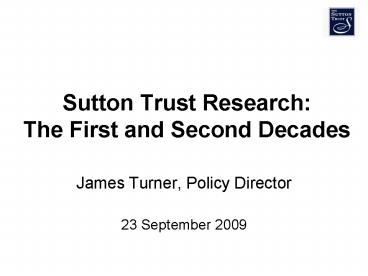Sutton Trust Research: The First and Second Decades PowerPoint PPT Presentation
1 / 11
Title: Sutton Trust Research: The First and Second Decades
1
Sutton Trust Research The First and Second
Decades
- James Turner, Policy Director
- 23 September 2009
2
Research
- Access to educational opportunity
- Over 30 studies mostly in HE, but also early
years, schools and social mobility - Tends to be quantitative
- Tends to focus on fair access portion of WP
agenda (but not always) - Concentration of opportunity and resulting waste
of talent
3
2004 Missing 3,000
- Based on HESA benchmarks
- 3,000 missing state students with grades to
attend top-ranked universities but who dont end
up there - State school pupils need two grades higher to
stand same chance of admission as independent
school peers - Similar story when you look at low SES groups and
poorer neighbourhoods
4
2007 Admissions by Individual School
- Analysis of 2002-06 UCAS admissions patterns for
3,700 individual schools - Dramatic concentration 100 elite schools made up
third of Oxbridge admissions one sixth of
admissions to Sutton 13 group - Not down to A-level results alone top performing
grammars and comprehensives under-represented
5
2009 Applications, offers and acceptances at
selective courses
- Pupils at top independent schools make twice as
many applications to leading universities as
peers from top comprehensives (and FE is
particular issue) - If admissions patterns were the same for
similarly qualified state and independent school
students, over 4,500 extra state school students
could enter top 500 university courses - No significant differences in offer rates
(although again, and FE dimension)
6
2008 Wasted Talent
- Combined NPD and HESA database
- 60,000 high performing state pupils do not go on
to higher education - When prior achievement taken into account,
virtually no gap between FSM and non-FSM children
poorer students who reach A-levels are as
likely to go on to higher education as their
better off peers - But still an access problem - FSM pupils less
likely to enter ST13
7
Our picture
- Huge inequalities in access
- Attainment is key driver, both pre and post GCSE
- Raising school standards intractable
- The other As Applications, Advice and
Aspirations are important too - What else needs to be done? Contextual
allowances? Pre-GCSE, sustained interventions?
Talent-spotting?
8
University chances in schools with different
characteristics
- Building on Wasted Talent report
- Quantify the school effect
- Same pupil different school context
- Where do, say, high-achieving FSM, pupils do well
and not so well in accessing universities? - Help to target work and inform admissions
allowances
9
STEP scheme
- International review of innovative schemes showed
students do just as well - A percent scheme for the UK, targeting top
students in disadvantaged schools pre GCSE - Contextual elements
- What progress do these students make against a
control group? - What entry allowances is it right to make? (very
little evidence)
10
Missing 3,000 explained
- Joint work with DBIS
- Tracking the motivations and decisions of
university applicants with three As and three Bs - Where do they end up?
- Rational decisions?
- How were choices made?
11
- Happy to hear new research / project ideas
- James.Turner_at_suttontrust.com
- Lee.ElliotMajor_at_suttontrust.com

